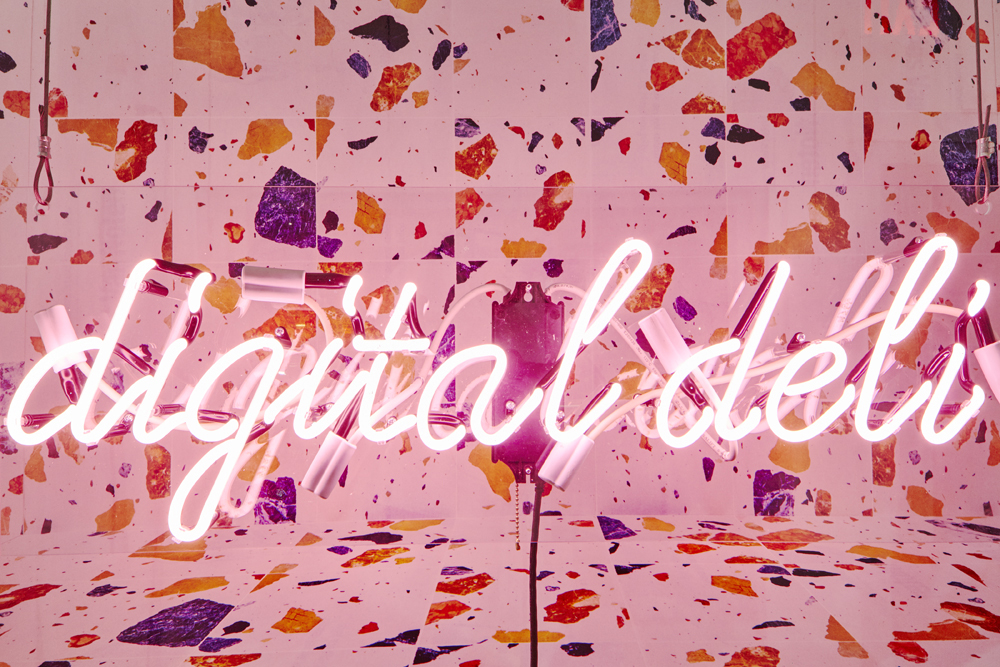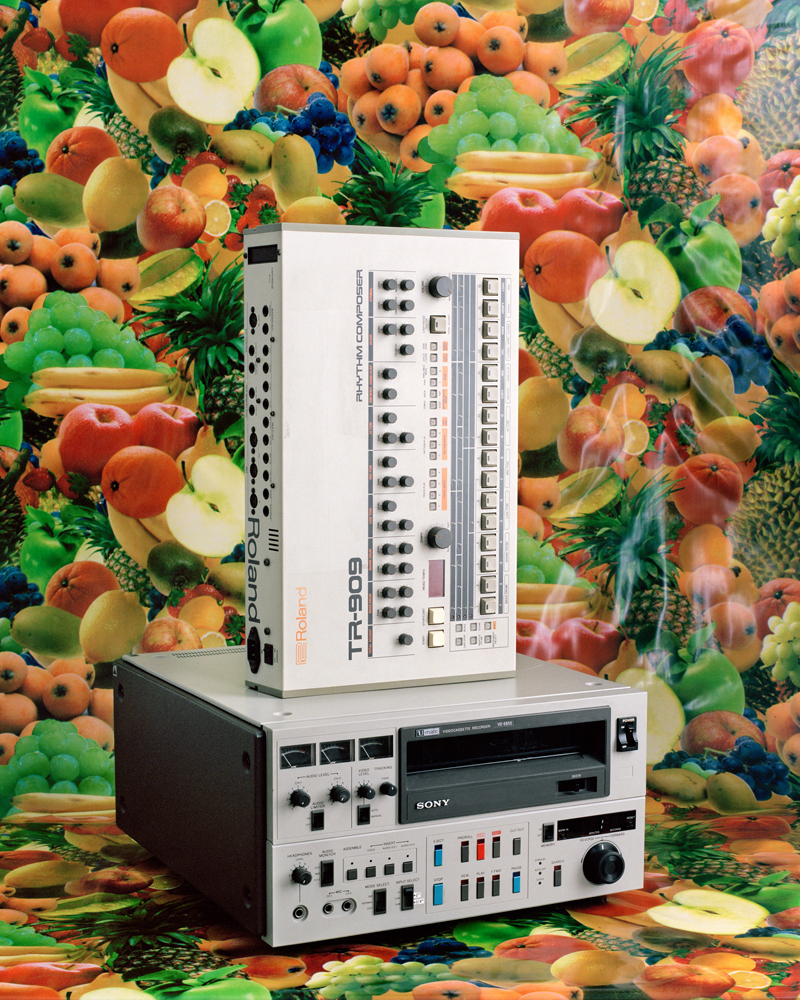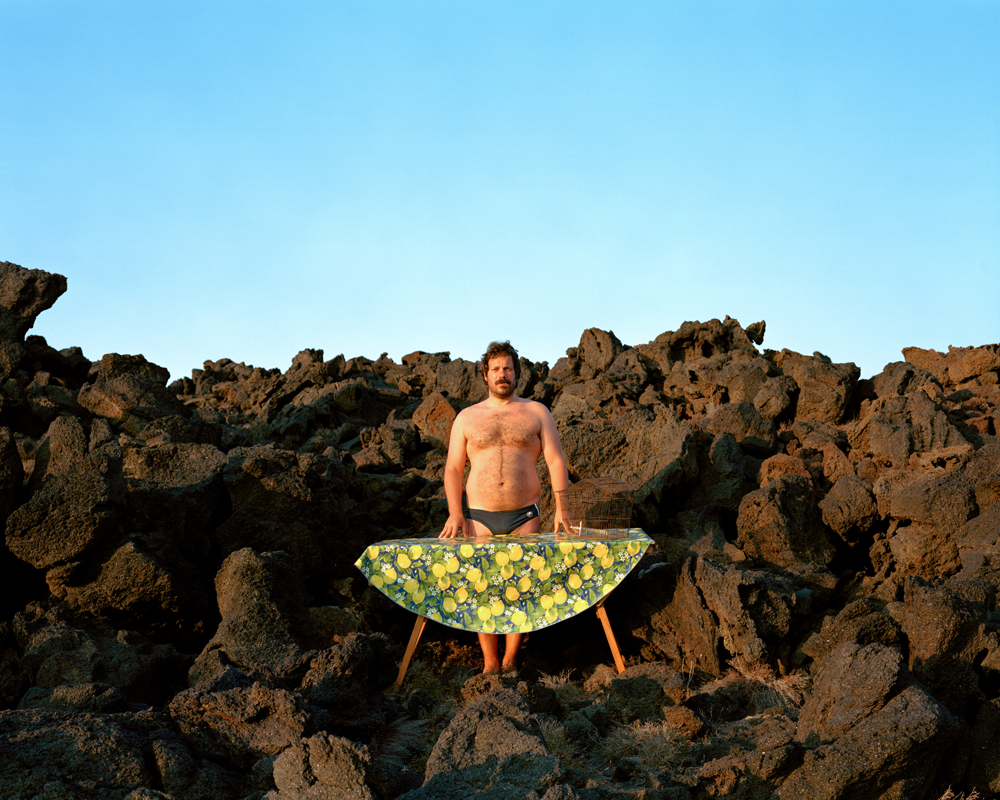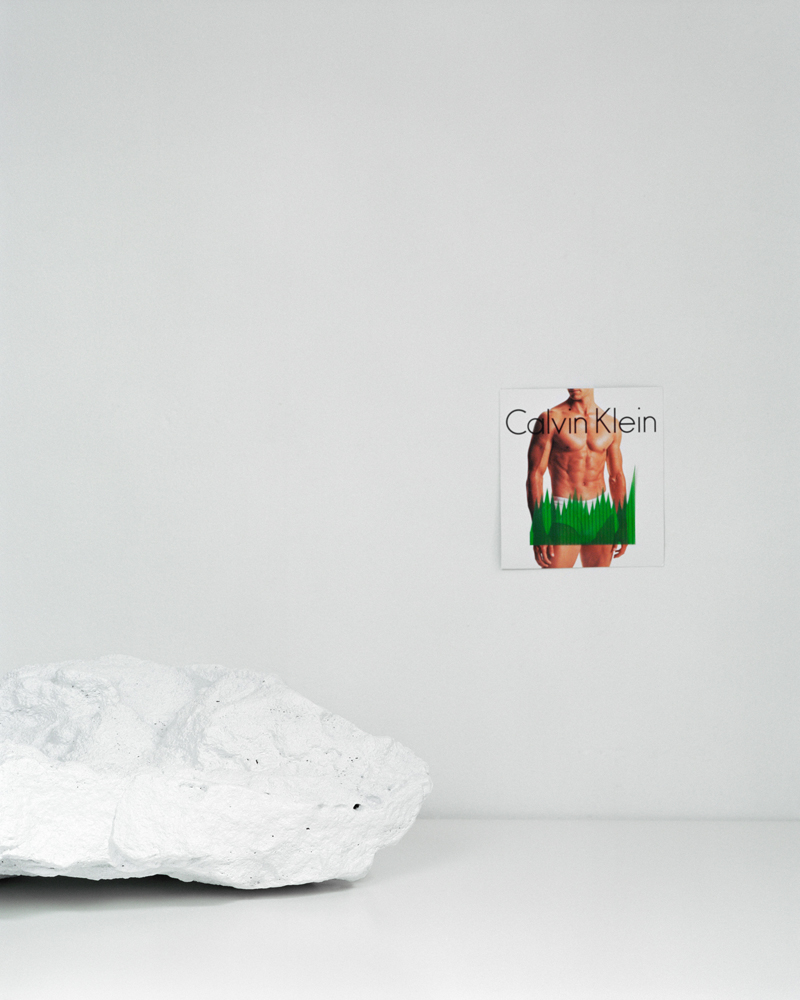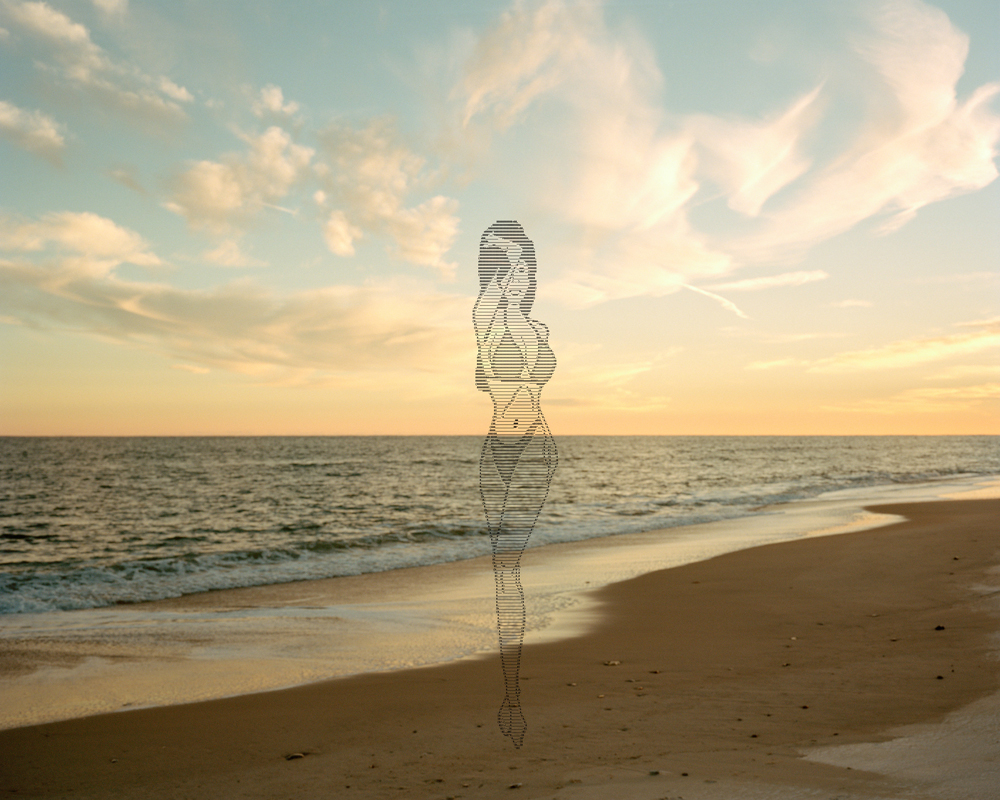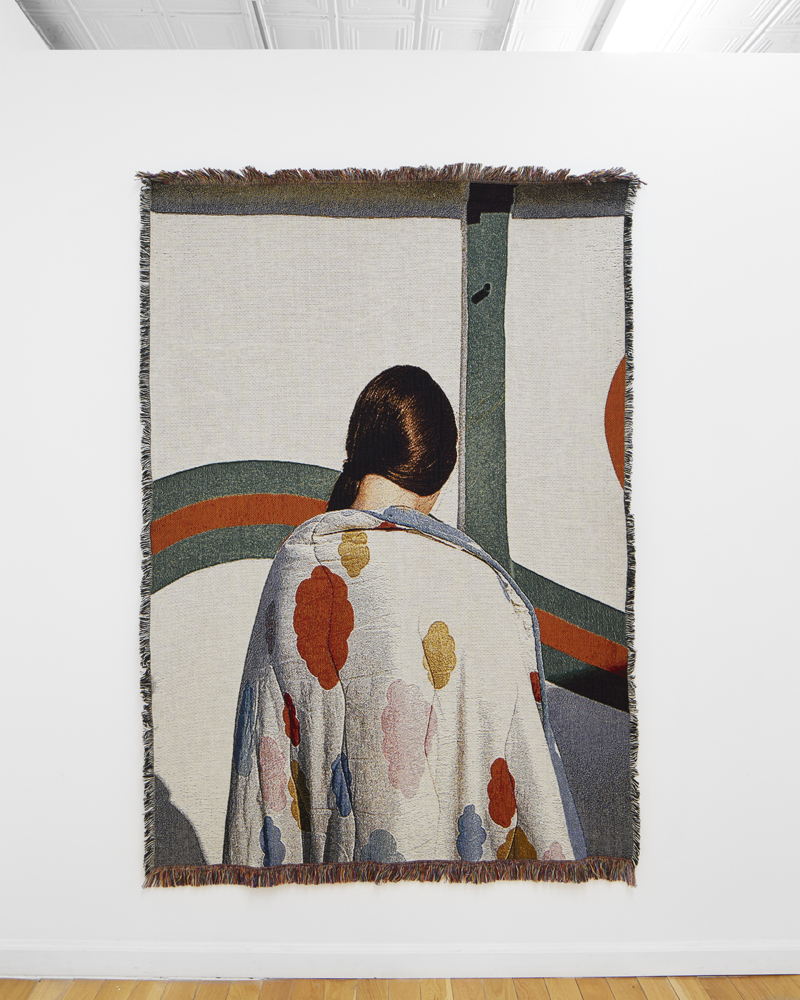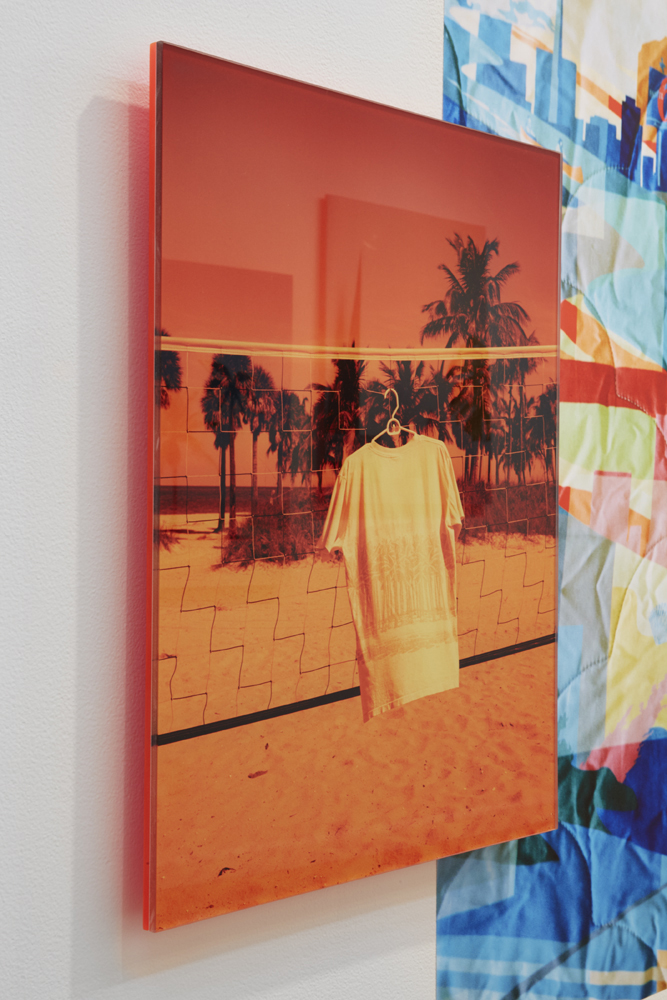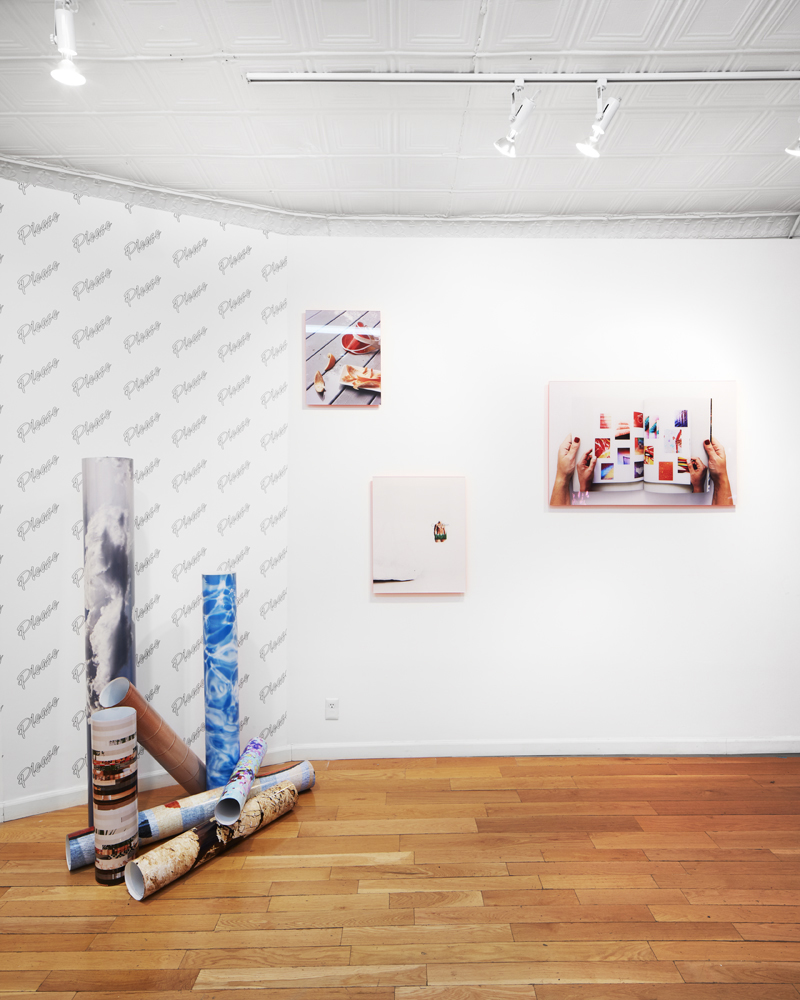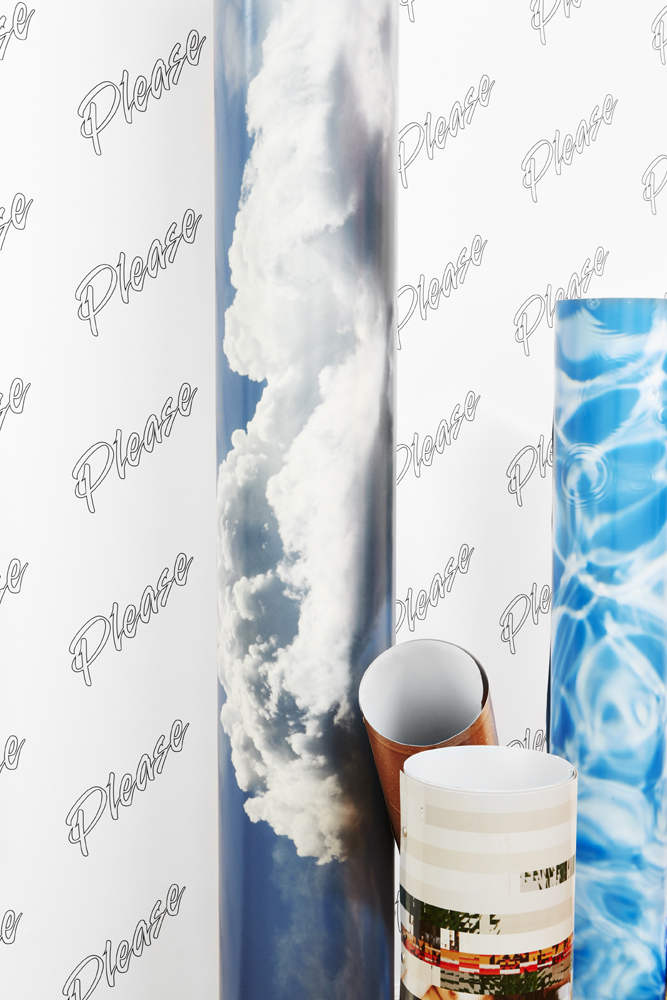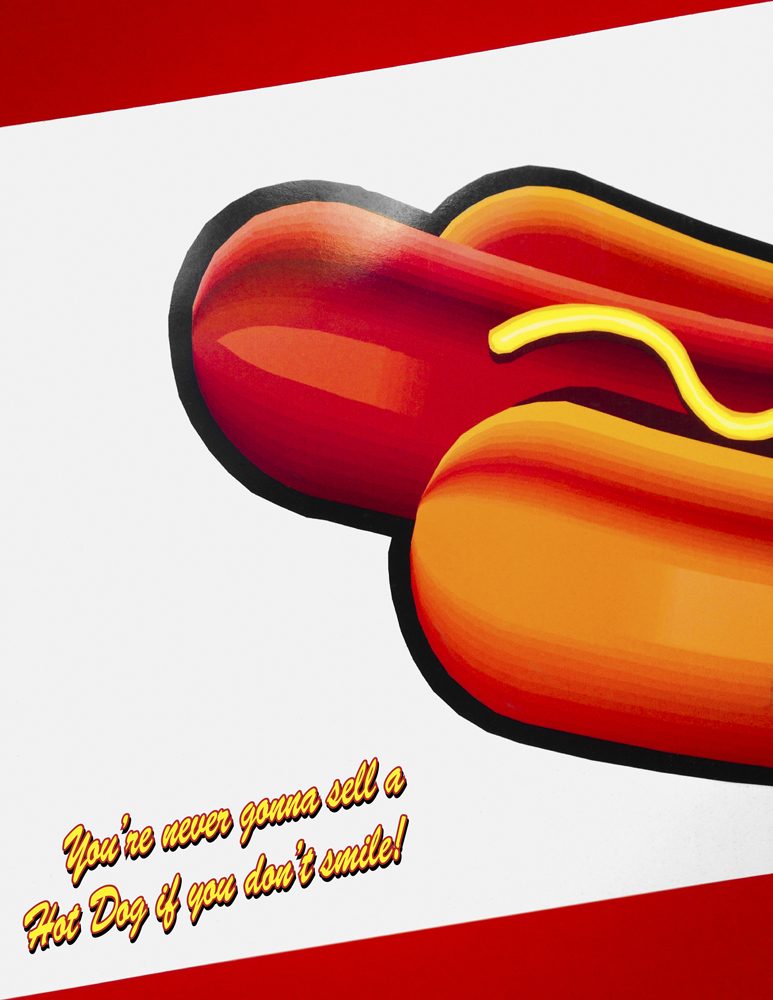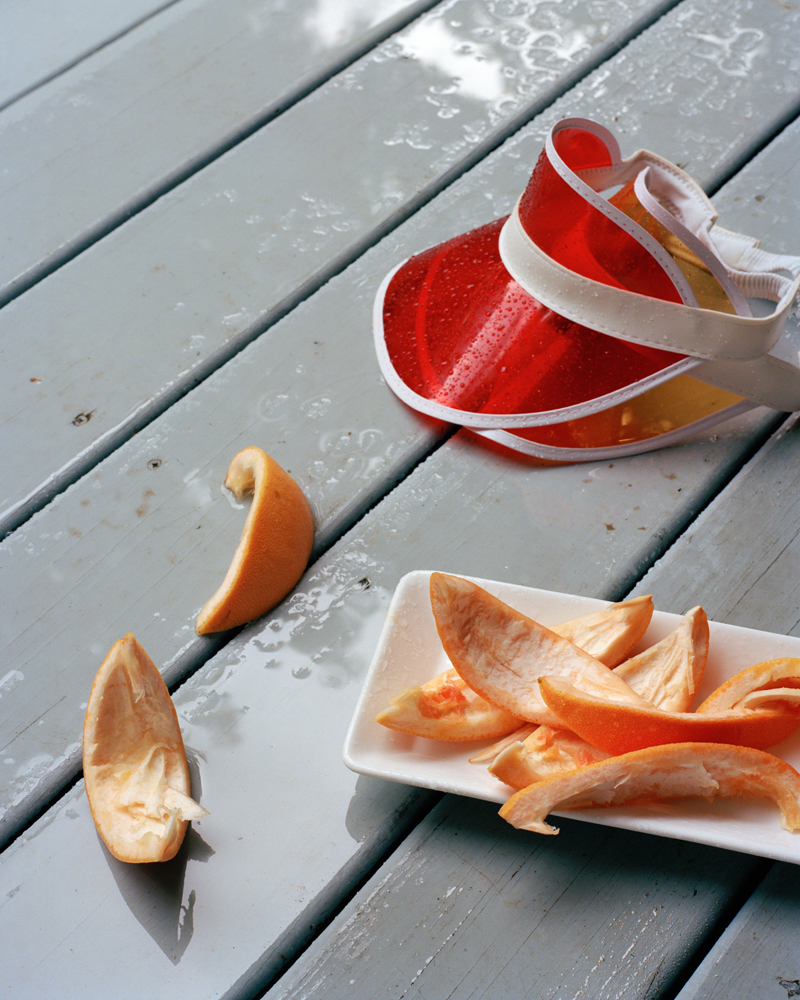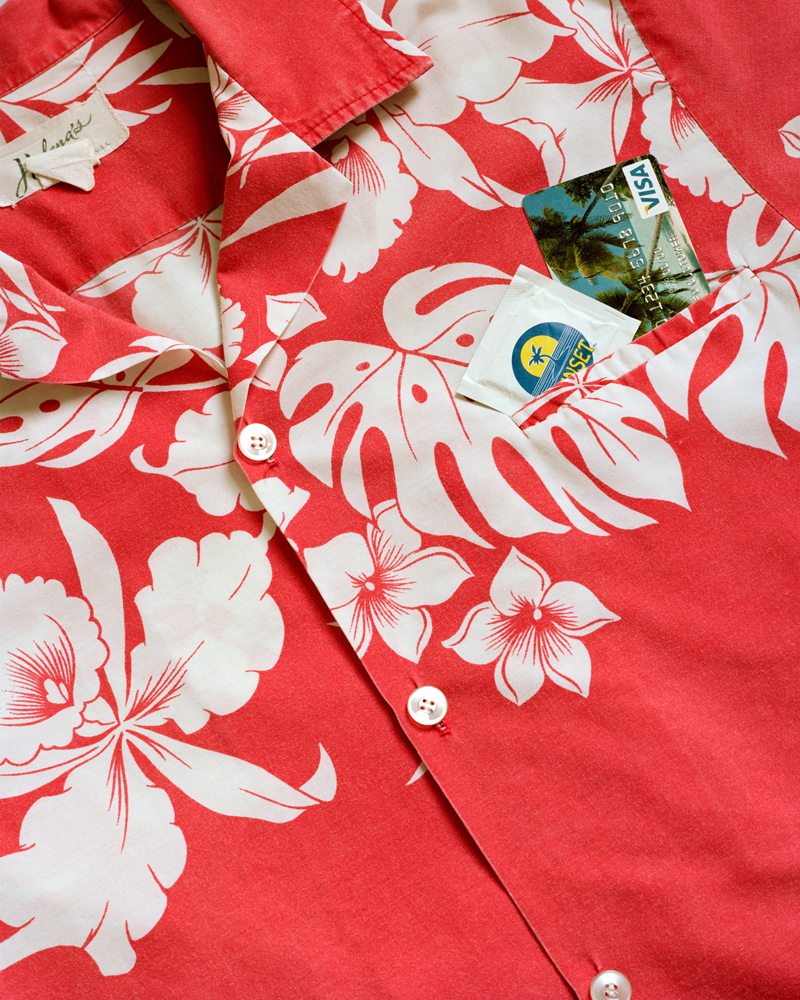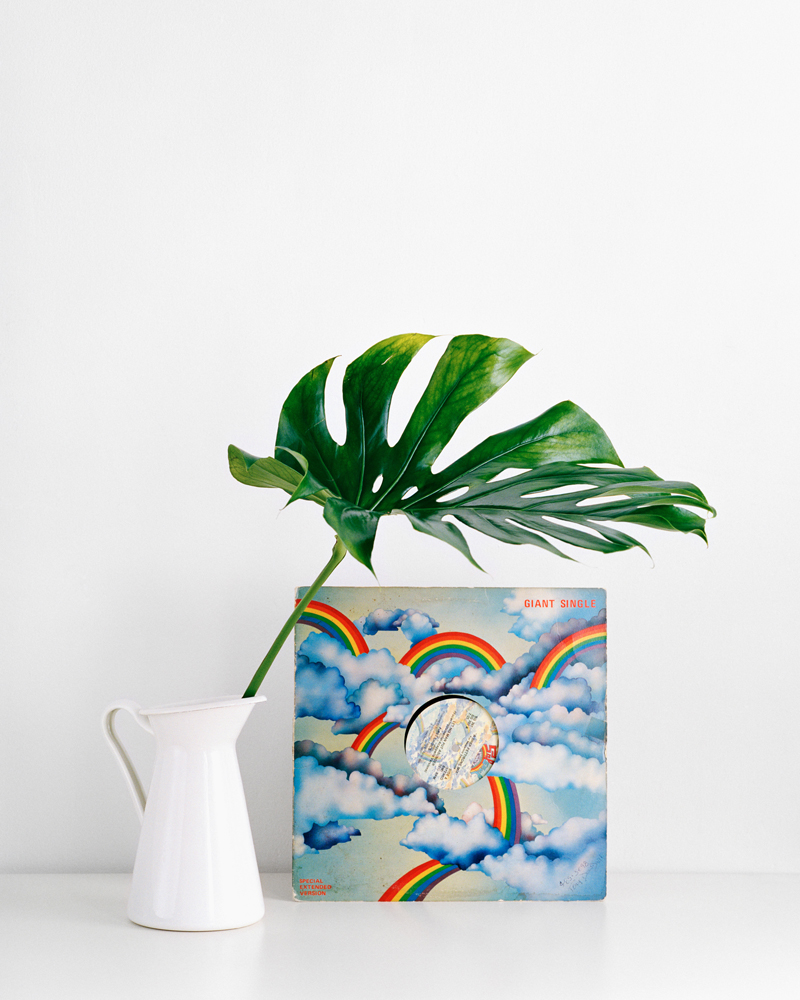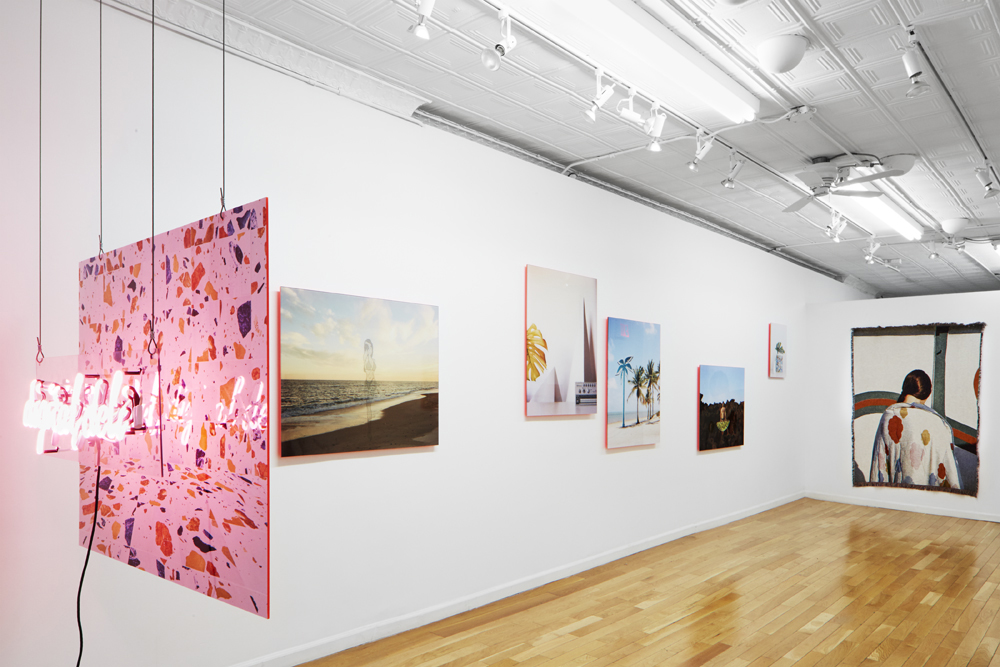Conversation with Marco Scozzaro on Digital Deli at Baxter St
Qiana Mestrich: Can you talk to me a little bit about the title and its reference to NYC bodegas (neighborhood convenience stores)?
Marco Scozzaro: That was the starting point. The work is an exploration of the current visual vernacular and I wanted to take different elements from the visual landscape and digest and work with them to create multilayered photographs and sculptures. As you can see the work is very diverse and in a way I like this idea of the deli as a place where you can find everything and anything… opposite elements that by being in the same space kind of make sense together. I’m playing a lot with natural vs. artificial/synthetic and opposite elements that seem unrelated but in the way I work with them they become organic.
This piece BETA 909 is where the project started from, the backdrop is a vinyl tablecloth that I found in a 99cents store in my neighborhood in Williamsburg, BK. In this still life I use obsolete technology like a Beta VHS player and a drum machine that I use to make music. I like the idea of the cheapness of the background that references nature against these electronic objects that were futuristic when they came out but are now obsolete and almost organic in this constructed image. So these elements don’t seem related but to me they make sense. From this point on I started playing with images and opposites, incorporating visual tropes or cultural artifacts like a Calvin Klein advertisement or referencing commercial photography, even appropriating my own work. In a way this work is a comment on the identity of photography and the inherent paradox of representation.
Is this a departure from the way you usually work or is more of you having a conversation with contemporary trend(s) in photography?
I wouldn’t say it’s a departure but I’m definitely exploring new possibilities and being open to new layers of interpretation. This image titled DAMASO LUNARE is what my previous work looked like. I guess the subject matter is very related. I’ve always been interested in exploring the relationship between society and personal identity. The previous work was more existential and with this new project I’m talking about the same things but using humor and adopting different strategies to deliver the same message. I’m also trying to make the work more accessible. I realize that the first layer of my images seems funny but if you dig deeper they’re not as accessible.
There’s definitely a lot to unpack in all of these images. They look simple on the surface and they’re very attractive and shiny but there’s lots of symbolism. I feel like there some larger social statement you’re trying to convey.
There is, I’m glad you noticed that. It’s not just a collection of nice pictures. I’ve always been interested in not glamorizing an image and non-conventional beauty but sometimes that intention has been misunderstood. I like playing with different languages in photography. I’m using still life, landscape… I’m rephotographing my pictures.
Yet there’s also decay and death and playing with the idea of the vanitas, not literally but in that same still life tradition.
Sure! In this picture 516N0RJ1N4 D16174L3, for example I’m making a comment on stereotypical images of the female body in mass media. This is an appropriated ASCII alphanumeric code. I found it interesting that this silhouette of a woman was totally unrelated to the content of the document where I found the image. And then I pasted the silhouette on a photograph of a landscape, that I made using film. Actually most of this work was shot on film, so I became very interested in this idea of using hybrid technology as a consequence of what the work is dealing with.
There’s also a sculptural quality in your work. The largest piece in the show is a blanket. Is that an image you’ve taken as well?
Yes, all of these images are mine. If there’s any appropriation it’s an image that has been rephotographed or inserted into my composition, like the Calvin Klein advertisement or the Giant Single record sleeve. That image titled DIGITAL CLOUDS on the blanket was a photograph I exhibited at Aperture last summer (Aperture Summer Open: Photography is Magic, curated by Charlotte Cotton). I’ve been thinking and playing around the idea of different materials and how they work with photographs. So at some point I found these digitally woven blankets – you have a jacquard loom that you can hook up to a computer to weave an image. The machine deconstructs the image in six threads to recreate all the colors. I like that this image was shot on film, then scanned and now it has a new life as a woven blanket instead of a print. And it’s also interesting as a “meta photographic concept” because the blanket references the blanket in the image.
It looks very painterly as well, so you’re tying multiple mediums together: the art of weaving, painting, photography…
Exactly. Also like this piece PALMS ON PALMS over BLANKETTO, which is one of the newest pieces… as you notice I’m trying to expand the two-dimensionality of photography in the space. The pictures themselves become objects. This particular fluorescent plexiglass that the photographs are back mounted on cast a glow on the white walls.
In this sculptural piece titled TUBBI, 2016 I wanted again to use opposites, images coming from fields that seem unrelated like rocks or a glitch from my computer or tiles or a pool or clouds and a carpet. The cylinder shape references the way you roll the paper when you make a large print that you just put on the floor and it stays in that shape. So I found a technical solution to let the prints stay in shape there a little longer… I like the idea of having these elements linked together, they become just texture. In a democratic way they are in the same space like when you are viewing multiple images on the monitor of your computer.
I would say SVIAGGIONI is the mood board for the project. I started taking visual notes with my iPhone and then at some point I realized there was something going on. The photos were re-posted to my Instagram and tumblr, so I had a template and I would see the pictures on my monitor in random order and in slightly different sizes. I printed all those pictures and played around with them and then I made a book. I photographed the book for a magazine feature (OSMOS) and I thought the picture itself was more interesting than the whole book. Then I rephotographed the image of my book in the magazine using different nail polish on the same hands holding the book open.
I thought it was interesting to have this double meaning that reflects the paradox of representation. This mood board combined organic with non-organic elements, associated by the color or shape, creating something visually pleasing but at the same time creating a starting point for new relations. From that book I realized I was working on something but I wasn’t 100% happy with the small prints so I used them as the starting point to make new images – either sculptures in the studio or created in post-production.
What about the word “Please” in this wallpaper?
Please was a way to explore the “bodega vernacular” like Thank you for your business or Have a nice day graphics on plastic bags… So I photographed those 80s/90s fonts, isolated the word “please” and started making this repeated pattern similar to the red carpet backgrounds with the sponsors on them that celebrities are photographed in front of. This piece is making a comment on how sometimes we’re over apologetic and over thankful and this gesture doesn’t even mean anything.
Yeah it’s not genuine, it’s just our own programming.
This way of working allowed me to play with text. Like this piece SMILE! I photographed this hot dog stand in midtown. I was on the street and I saw this grumpy hot dog guy and someone just passed and said “You’re never gonna sell a hotdog if you don’t smile!” And I thought that phrase was a metaphorical way of describing our society.
Do you think this work is a statement on American culture or is there a more of a world view here?
It definitely starts from an American point of view. I’m not American but I’ve been living here for seven years assimilating into the culture of course. Also I realize that I grew up with Western influence through television. I don’t want to talk about American imperialism but there is a cultural hegemony that in a way is coming back. Now as an adult being here and experiencing everyday American life a lot of it seems like déjà vu and I’m starting to understand the messages that I couldn’t understand as a kid.
The work definitely talks about mass media and how our perception is influenced by them. Like this image of the Hawaiian shirt and the VISA credit card, which is also a reference to my own situation as an immigrant… These are not literal but hidden or unconscious links, thoughts that come to mind when I look at the images after the fact.
It’s nice because the aesthetic is not overtly political but as you dig deeper you do get some undertones.
I didn’t want to make political work but I realize that…
Everything is political.
Exactly. Especially looking at what is going on now in America, I see this work as very political. For example, in Italy we had Prime Minister Berlusconi who as a media tycoon became a politician because of his fortune and influence. So in a way with Trump we are kind of seeing the same thing happening. I didn’t want to mention Trump because he’s not relevant here but I think the work is observing what mass media can do, good or bad. So I wanted to create images that look good but also give a starting point for a conversation that is not about being frivolous.
Marco Scozzaro’s solo show, Digital Deli, is on view at Baxter St now through March 25, 2017.
Qiana Mestrich is a photographer, writer, digital marketer and mother from Brooklyn, NY. She is the founder of Dodge & Burn: Decolonizing Photography History, a blog that seeks to establish a more inclusive history of photography, highlighting contributions to the medium by and about people of underrepresented cultures.
Read her other guest posts on the Baxter St blog:
Five Visual Motifs in the Photographs of Ren Hang
Photography and the Black Panther Party
The Black Female Self in Landscape
In Memoriam: John Berger and Uses of Photography Quotes
Forthcoming Photobooks by African American and Black African Photographers
New Image Library Specializes in Race and Cultural Diversity
